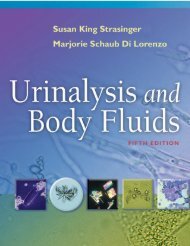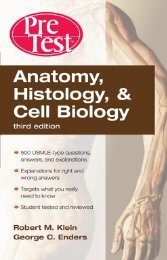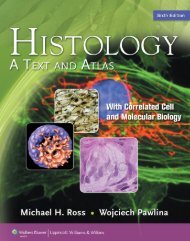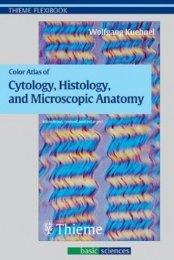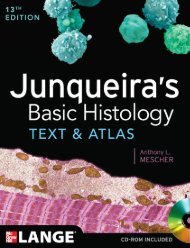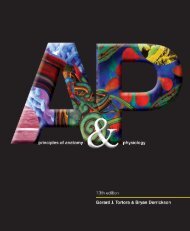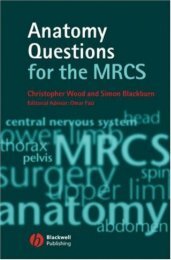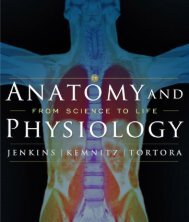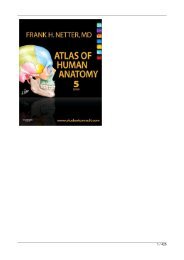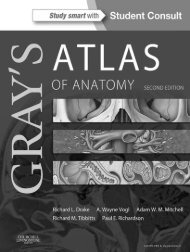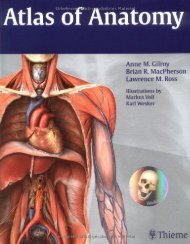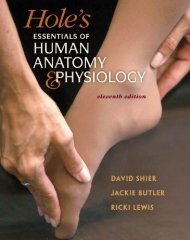theanatomyandphysiologylearningsystem4epdfdr-150930024720-lva1-app6891
Create successful ePaper yourself
Turn your PDF publications into a flip-book with our unique Google optimized e-Paper software.
Chemistry, Matter, and Life<br />
2<br />
CHAPTER OBJECTIVES<br />
Elements<br />
• Define matter, element, and atom.<br />
• Use chemical symbols to identify elements.<br />
Structure of Atoms<br />
• Illustrate the structure of an atom with a simple<br />
diagram showing the protons, neutrons, and electrons.<br />
• Distinguish between the atomic number and<br />
mass number of an element.<br />
• Describe the electron arrangement that makes an<br />
atom most stable.<br />
Isotopes<br />
• Distinguish between isotopes and other atoms.<br />
• Describe a radioactive isotope.<br />
Chemical Bonds<br />
• Describe the difference between ionic bonds,<br />
covalent bonds, and hydrogen bonds.<br />
Chemical Reactions<br />
• Describe and write chemical equations for four<br />
types of chemical reactions and identify the<br />
reactants and products in each.<br />
• Discuss five factors that influence the rate of<br />
chemical reactions.<br />
Mixtures, Solutions, and Suspensions<br />
• Distinguish between mixtures, solutions, and<br />
suspensions.<br />
Electrolytes, Acids, Bases, and Buffers<br />
• Differentiate between acids and bases and<br />
discuss how they relate to pH and buffers.<br />
Organic Compounds<br />
• Describe the five major groups of organic<br />
compounds that are important to the human<br />
body.<br />
Compounds and Molecules<br />
• Describe the relationship between atoms,<br />
molecules, and compounds and interpret<br />
molecular formulas for compounds.<br />
KEY TERMS<br />
Acid (AS-id) Substance that ionizes in water<br />
to release hydrogen ions; a proton donor; a<br />
substance with a pH less than 7.0<br />
Atom (AT-tum) Smallest unit of a chemical element<br />
that retains the properties of that element<br />
Base (BASE)Substance that ionizes in water to<br />
release hydroxyl (OH − ) ions or other ions that<br />
combine with hydrogen ions; a proton acceptor; a<br />
substance with a pH greater than 7.0; alkaline<br />
Buffer (BUFF-fur) Substance that prevents, or<br />
reduces, changes in pH when either an acid or a<br />
base is added<br />
Carbohydrate (kar-boh-HYE-drayt) Organic<br />
compound that contains carbon, hydrogen, and<br />
oxygen with the hydrogen and oxygen present in<br />
a 2:1 ratio; sugar, starch, cellulose<br />
Compound (KAHM-pownd) Substance formed<br />
from two or more elements joined by chemical<br />
bonds in a definite, or fixed, ratio; smallest unit of<br />
a compound is a molecule<br />
Covalent bond (koe-VAY-lent BOND) Chemical<br />
bond formed by two atoms sharing one or more<br />
pairs of electrons<br />
Element (EL-eh-ment) Simplest form of matter that<br />
cannot be broken down by ordinary chemical<br />
means<br />
Inorganic Compound (in-or-GAN-ik KAHMpownd)<br />
Chemical components that do not<br />
contain both carbon and hydrogen.<br />
Ionic bond (eye-ON-ik BOND) Chemical bond<br />
that is formed when one or more electrons are<br />
transferred from one atom to another<br />
Isotope (EYE-so-tohp) Atoms of a given element<br />
that have different numbers of neutrons and<br />
consequently different atomic weights<br />
Lipid (LIP-id) Class of organic compounds that<br />
includes oils, fats, and related substances<br />
Molecule (MAHL-eh-kyool) Particle composed of<br />
two or more atoms that are chemically bound<br />
together; smallest unit of a compound<br />
Organic Compound (or-GAN-ik KAHM-pownd)<br />
Chemical components that contain carbon and<br />
hydrogen atoms covalently bonded together.<br />
Protein (PRO-teen) Organic compound that<br />
contains nitrogen and consists of chains of amino<br />
acids linked together by peptide bonds<br />
Radioactive isotope (ray-dee-oh-ACK-tiv EYE-sotohp)<br />
Isotope with an unstable atomic nucleus that<br />
decomposes, releasing energy or atomic particles<br />
Solute (SOL-yoot) Substance that is dissolved in a<br />
solution<br />
Solvent (SOL-vent) Fluid in which substances dissolve<br />
21




